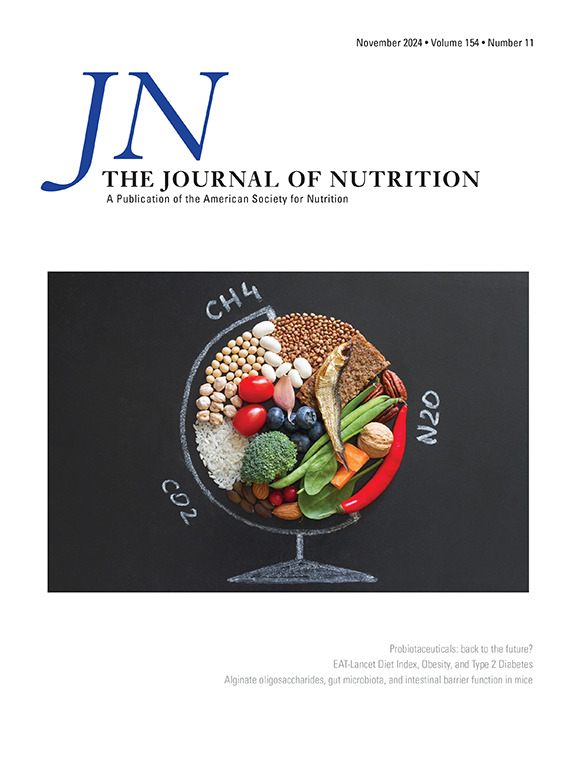Consumption of Low-Calorie Sweeteners among Children Aged 6 Months to 5 Years in the United States, NHANES 2017–2020
IF 3.7
3区 医学
Q2 NUTRITION & DIETETICS
引用次数: 0
Abstract
Background
Although the American Academy of Pediatrics advises against low-calorie sweeteners (LCS) consumption by children <5 y due to potential health and development concerns, the extent of this consumption among these children is unknown.
Objectives
The objective of this study was to describe the intake, sources, and dietary patterns associated with LCS consumption among United States infants and preschoolers.
Methods
We used cross-sectional 24-h dietary recall data (day 1) among 1497 children aged 6 mo to 5 y from the National Health and Nutrition Examination Survey 2017–2020 prepandemic. Complex survey procedures and sampling weights were applied to compare LCS consumption patterns (prevalence and frequency [times/day] of any LCS, any LCS-containing beverages [LCSBs], and any LCS-containing foods [LCSFs], with each occurrence of consumption = 1 “serving”) across demographic subgroups and to assess the associated nutrients and % of total energy intake (TEI).
Results
Thirty-one percent of children aged 6 mo to 5 y consumed ≥1 LCSB and/or LCSF on a given day. The prevalence of LCS consumption increased with age, 10.5% (6 to <12 mo) to 34.3% (2–5 y). Among LCS consumers, mean serving frequency was 1.4 times/d, with no differences by age or sex. Of all LCSBs servings consumed, 64.0% were fruit drinks; 57.8% of all LCSFs servings were non-Greek yogurt. As consumption levels increased from no LCS to >1 serving/d, intake of the following also increased: total sugar (+1.8% TEI, P-trend = 0.04), added sugar (+1.1%, P-trend = 0.048), sodium (+304 mg, P-trend = 0.04), and fiber (+0.8 g, P-trend = 0.01). In contrast, protein intake was lower (−0.7% TEI, P-trend = 0.02). Those consuming 1 LCS serving/d consumed more total energy than LCS nonconsumers (1606 compared with 1401 kcal), but TEI did not increase further with >1 LCS serving/d (1607 kcal). LCS consumption was not associated with carbohydrate or fat intake.
Conclusions
LCS consumption, primarily from fruit drinks and non-Greek yogurt, is prevalent among United States preschoolers, and this consumption is associated with greater intake of total sugar, added sugar, and sodium.
美国 6 个月至 5 岁儿童的低热量甜味剂消费情况,NHANES 2017-2020 年。
背景:美国儿科学会建议儿童不要食用低热量甜味剂(LCS):描述美国婴幼儿和学龄前儿童摄入低热量甜味剂的相关情况、来源和饮食模式:我们使用了美国国家健康与营养调查(NHANES)2017-2020 年大流行前对 1,497 名 6 个月至 5 岁儿童的 24 小时膳食回顾横断面数据(第 1 天)。采用复杂的调查程序和抽样权重,比较不同人口亚群的低碳水化合物消费模式(任何低碳水化合物、任何含低碳水化合物饮料[LCSBs]和任何含低碳水化合物食品[LCSFs]的流行率和频率[次数/天],每次消费=1 "份"),并评估相关营养素和总能量摄入量(TEI)的百分比:结果:31%的 6 个月至 5 岁儿童在某一天食用了≥1 份低碳水化合物和/或低碳水化合物食品。食用低碳水化合物的比例随着年龄的增长而增加,为 10.5%(6-1 份/天,以下食物的摄入量也随之增加:总糖(+1.8% TEI,p-trend=0.04)、添加糖(+1.1%,p-trend=0.048)、钠(+304 毫克,p-trend=0.04)和纤维(+0.8 克,p-trend=0.01)。相比之下,蛋白质摄入量较低(-0.7% TEI,p-趋势=0.02)。每天摄入 1 份低碳水化合物的人比不摄入低碳水化合物的人摄入更多的总能量(1606 千卡对 1401 千卡),但每天摄入>1 份低碳水化合物(1607 千卡)后,总能量摄入量没有进一步增加。低碳水化合物摄入量与碳水化合物或脂肪摄入量无关:结论:在美国学龄前儿童中,主要从水果饮料和非希腊酸奶中摄入低碳水化合物的现象很普遍,而且这种摄入与总糖、添加糖和钠的摄入量增加有关。
本文章由计算机程序翻译,如有差异,请以英文原文为准。
求助全文
约1分钟内获得全文
求助全文
来源期刊

Journal of Nutrition
医学-营养学
CiteScore
7.60
自引率
4.80%
发文量
260
审稿时长
39 days
期刊介绍:
The Journal of Nutrition (JN/J Nutr) publishes peer-reviewed original research papers covering all aspects of experimental nutrition in humans and other animal species; special articles such as reviews and biographies of prominent nutrition scientists; and issues, opinions, and commentaries on controversial issues in nutrition. Supplements are frequently published to provide extended discussion of topics of special interest.
 求助内容:
求助内容: 应助结果提醒方式:
应助结果提醒方式:


